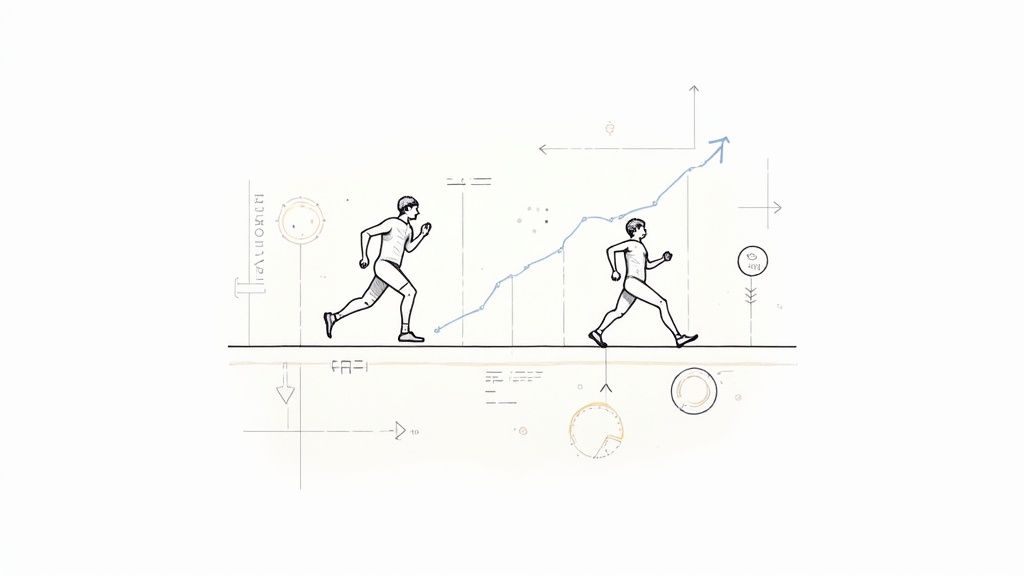
ppc and seo working together
PPC and SEO Working Together to Boost Your ROI
Posted on Oct 28, 2025

It’s time to stop thinking of SEO and PPC as two sides of a coin. Forget the rivalry. Instead, think of them as a tag team: PPC is your star sprinter, racing ahead to grab immediate traffic and priceless data, while SEO is your marathon runner, steadily building the brand authority and trust that lasts.
When you make PPC and SEO work together, you’re not just running two separate plays. You’re creating a unified offensive that’s far more powerful than the sum of its parts.
Why SEO and PPC Are Stronger Together
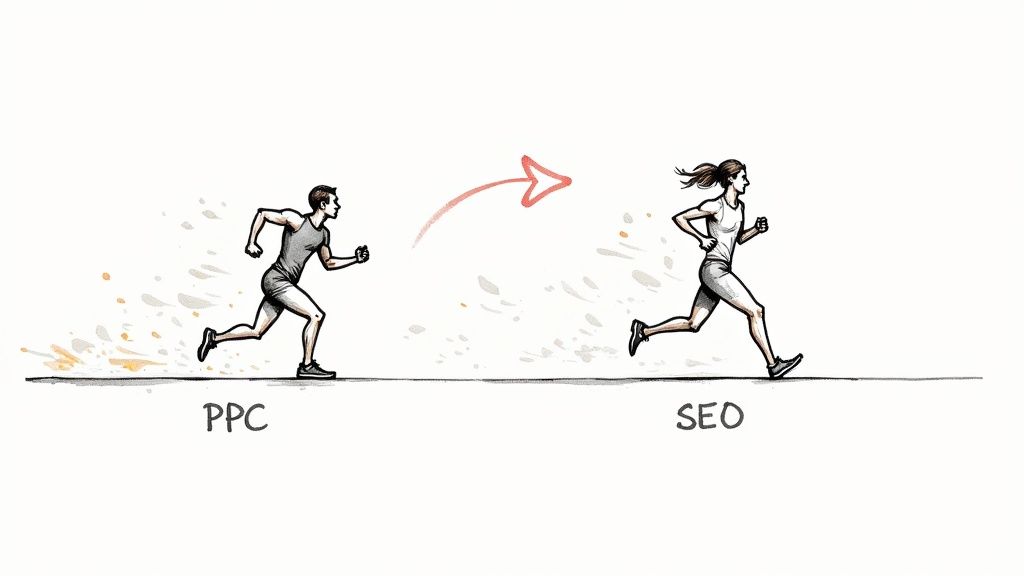
It's common for businesses to treat paid and organic search as totally separate worlds. Often, they're handled by different teams with different goals, stuck in their own silos. This is a massive missed opportunity.
When you integrate these two powerhouses, they start talking to each other. They share data, cover each other's weaknesses, and amplify their strengths, giving you maximum visibility where it counts: the search engine results page (SERP).
PPC vs SEO At a Glance
Let's break down the core differences and complementary roles of these two channels. The table below gives a quick snapshot of how each one operates and what it brings to the table.
| Attribute | PPC (Pay-Per-Click) | SEO (Search Engine Optimization) |
|---|---|---|
| Speed to Results | Immediate—traffic starts as soon as the campaign is live | Gradual—typically takes months to see significant results |
| Cost Model | Pay per click/impression | No direct cost per click, but requires investment in content, tech, and expertise |
| SERP Placement | Top of the page (ad section) | Below the ads (organic results) |
| Primary Goal | Drive immediate traffic, leads, and sales; test offers | Build long-term authority, credibility, and sustainable traffic |
| Longevity | Traffic stops when you stop paying | Results are durable and can compound over time |
| Targeting | Highly specific (demographics, location, keywords, etc.) | Broader targeting based on search intent and content relevance |
As you can see, their strengths are almost perfectly complementary. One delivers the quick wins and actionable data, while the other builds the foundation for lasting success.
The Power of a Unified Front
PPC is all about speed and precision. You can launch a campaign in the morning and have traffic, leads, and keyword data pouring in by the afternoon. This makes it perfect for testing a new "book direct" offer, reacting to a competitor's promotion, or capturing last-minute bookings for a local event.
SEO, on the other hand, is your long game. It's the slow-and-steady work of building credibility, earning trust, and becoming the go-to resource in your market. This effort pays off with a consistent flow of high-quality traffic that you don't have to pay for on a per-click basis. And that's huge, considering organic traffic accounts for a massive 53.3% of all web traffic.
When you combine them, you get the best of both worlds. The data backs this up. Roughly 70% of users click on organic links over paid ads because they see them as more credible.
By appearing in both the paid and organic results for your most important keywords, your brand doesn't just show up—it dominates. This double-dip on the SERP sends a powerful signal to potential guests: you are a leading, trustworthy authority in your space.
This integrated approach is a game-changer in competitive markets, a concept we dive into deeper in our guide on SEO for vacation rentals.
Ultimately, a combined strategy creates a powerful feedback loop. The quick insights from your paid campaigns sharpen your organic strategy, while your strong organic presence builds trust and can even lower your ad costs over time. It's a win-win that drives real business growth.
Unlock Smarter Targeting with Shared Keyword Data
What if you had a crystal ball? One that told you exactly which keywords would bring in paying guests before you spent months trying to rank for them organically.
That’s pretty much what you get when your PPC and SEO efforts share data. Your paid campaigns effectively become a rapid-testing lab, giving you almost instant feedback on which search terms actually lead to clicks and, more importantly, bookings.
This simple idea completely flips traditional SEO on its head. Instead of guessing which keywords show the most booking intent, you use PPC to prove it. For a tiny fraction of the cost and time of a full-blown organic campaign, you can discover that a specific phrase like "pet-friendly cabin with hot tub" converts at double the rate of a more generic one like "cabin rentals near hiking trails."
Mine Your PPC Reports for SEO Gold
All this valuable data is just sitting inside your Google Ads account, waiting to be discovered. When you dig into your search terms report, you can see the exact queries people typed right before clicking your ad.
Your goal is to find your "money" keywords—the ones with a solid click-through rate (CTR) and a high conversion rate. These are the proven winners, and they should immediately jump to the top of your SEO priority list.
Think of it like this: PPC is your reconnaissance team. It ventures into the battlefield of the search results, quickly identifies the most valuable targets (your high-converting keywords), and reports back so your main army (SEO) can move in and establish a permanent stronghold.
The Google Ads Paid & Organic report is perfect for this, as it shows you how your paid and organic results are performing side-by-side when your accounts are linked.
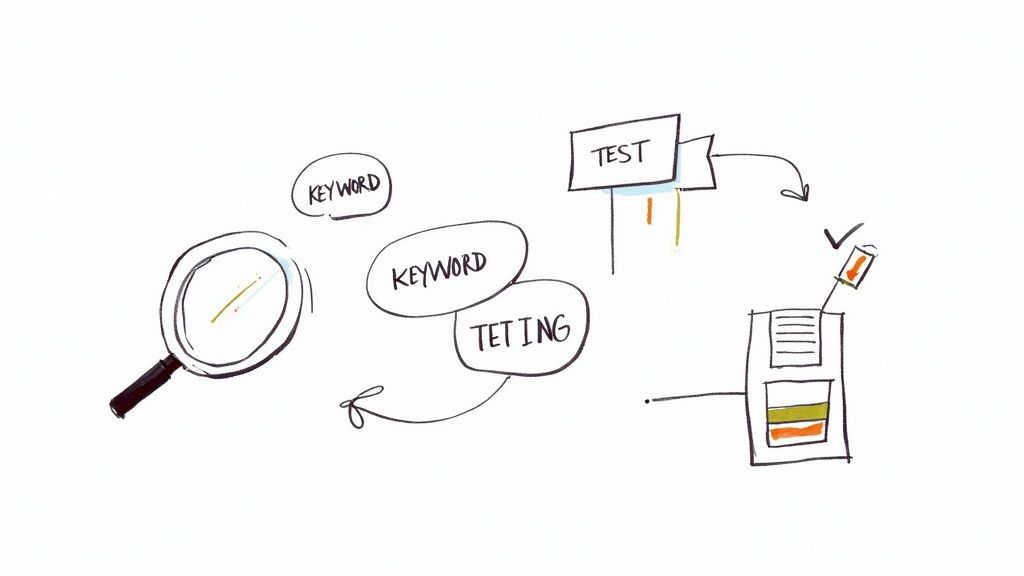
This report gives you a unified view of your search presence, showing how often your website appeared in organic results when one of your ads was also triggered for the same query.
Turn PPC Insights into SEO Action
Once you’ve found your best-performing paid keywords, it’s time to put that intelligence to work for your organic strategy. This creates a powerful feedback loop where PPC and SEO working together builds an unstoppable presence in search.
Here’s a simple process you can follow:
- Export Your Data: Download the search terms report from your most successful Google Ads campaigns. Make sure to focus on keywords with high conversion rates.
- Analyze and Prioritize: Filter that list to find the terms that not only convert well but also have a decent search volume. These are your top SEO targets.
- Create Targeted Content: Start building dedicated blog posts, landing pages, or even FAQ sections around these proven keywords. If "luxury beachfront rental with private pool" is a top converter in your ads, you should have a detailed page showcasing those exact properties.
By following this process, you’re transforming SEO from an educated guess into a data-driven strategy. You’re no longer just hoping a keyword will perform; you’re building content around terms you already know your ideal guests use when they’re ready to book. This alignment ensures every piece of content you create has a proven purpose and a much higher chance of driving direct revenue.
Crafting High-Converting Ads and Landing Pages
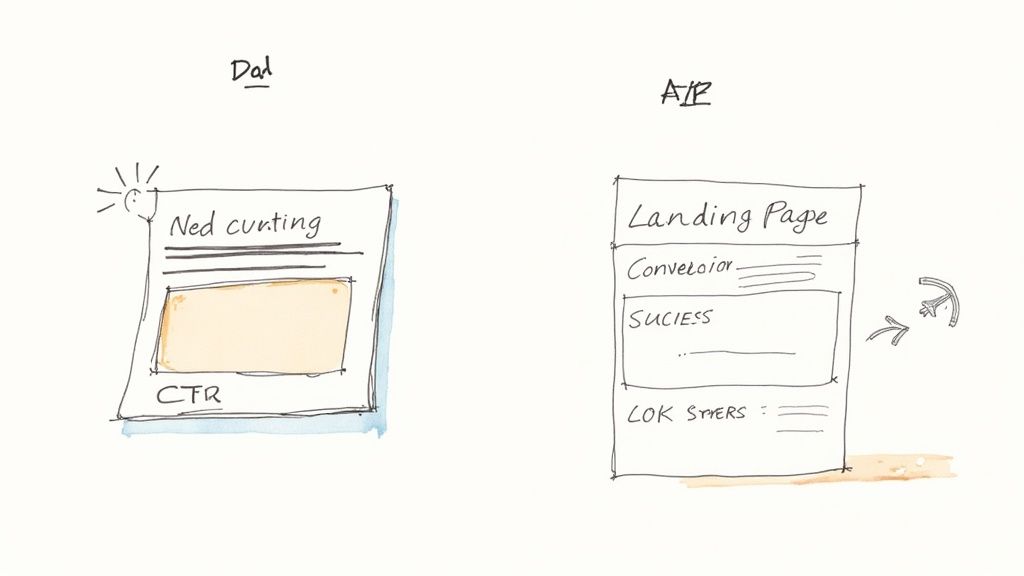
This is where the real magic happens—using the insights from one search channel to sharpen the performance of the other. Think of your PPC campaigns as a rapid-fire testing ground. You can A/B test ad copy, headlines, and calls-to-action to discover, in real-time, which messages actually get people to click.
Once you find a winning combination, you’ve struck gold. That high-performing ad copy isn't just for ads anymore; it’s a proven blueprint for your organic strategy. You can plug those headlines and descriptions directly into your organic page titles and meta descriptions, taking the guesswork out of the equation and giving your organic click-through rates a serious boost.
Let Organic Performance Guide PPC
But this isn't a one-way street. Your top-performing organic pages—the ones with rock-bottom bounce rates and high time-on-page metrics—are a treasure trove of information. These pages are clearly hitting the mark, giving visitors exactly what they came for.
Take a hard look at the structure and flow of these pages. What information do they lead with? What kind of language do they use? How are the calls-to-action phrased? This analysis gives you a battle-tested framework for building more effective PPC landing pages.
When a landing page perfectly aligns with your ad copy and the user’s original search, Google Ads rewards you with a higher Quality Score. This is a huge win. It not only lowers your cost-per-click but also bumps up your ad position, making every dollar you spend work harder.
Building a Consistent User Journey
When your paid ads echo your organic messaging, and your PPC landing pages are built on the foundation of your best organic content, you create a seamless experience for the user. This consistency is crucial for building trust and reinforcing your brand at every single touchpoint.
Whether a guest finds you through a paid ad or an organic result, they get a familiar, optimized experience that’s designed from the ground up to guide them toward booking.
Here's something to think about: organic search conversions average 2.4%, which is almost double the typical PPC conversion rate of 1.3%. Why the gap? It often comes down to the trust and relevance you build with high-quality organic content. By using your SEO insights to shape your PPC landing pages, you can start closing that gap and lift conversions across the board.
If you want to speed up the process, you can find great landing page design templates that already incorporate many of these best practices.
This cross-channel optimization is the core principle of making PPC and SEO working together. You're not just running two separate campaigns in parallel. You're building a powerful feedback loop where each channel constantly learns from and improves the other, leading to better results and a much higher return on your marketing investment.
Dominating the SERP with a Unified Presence
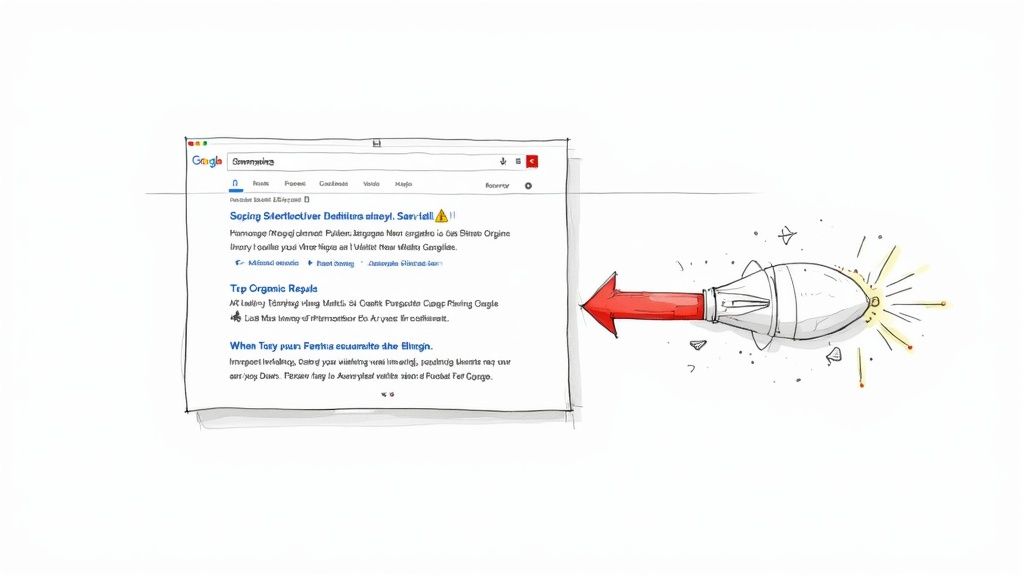
Picture this: a guest searches for their perfect vacation rental, and your brand is the first thing they see—twice. That's the power of owning both the top paid ad and the #1 organic spot on the search engine results page (SERP). It's more than just showing up; it's about establishing complete dominance.
When a potential guest sees your brand in both places, it sends a powerful psychological signal. You aren't just another option on a long list; you are the leading authority. This dual presence builds massive credibility and trust before they even click.
And this strategy of having PPC and SEO working together isn't just for show. It has a real impact on your total click-through rate (CTR). Some people are conditioned to click ads, while others instinctively scroll right past them to the organic results. By appearing in both prime positions, you capture clicks from both groups, maximizing your share of that valuable traffic.
When a Dual Presence Is Non-Negotiable
While this unified approach is a great goal for any keyword, there are a couple of scenarios where it becomes absolutely critical. Think of it as both a defensive and an offensive play that drives tangible results.
You need to be all over this strategy for:
- Defending Your Brand: Even if you rank #1 organically for your brand name, competitors can (and will) bid on your keywords to place their ads above you. Running your own branded PPC ads is a non-negotiable defensive move. It pushes them down the page and ensures you control the message and the destination for your most valuable, high-conversion traffic.
- High-Intent Commercial Keywords: We're talking about searches like "oceanfront condo with pool" or "last-minute cabin rental," where the user’s intent to book is sky-high. Securing both the ad and the organic spot ensures you snatch up as much of this ready-to-book traffic as possible, leaving very little room for anyone else.
By occupying more SERP real estate, you effectively push competitors further down the page—sometimes even below the fold. This crushes their visibility and funnels more attention directly to your listings.
Aligning Bids with Organic Rankings
The key to pulling this off efficiently is to align your PPC bidding with your organic performance. If you already hold the number one organic spot for a keyword, you probably don't need to bid quite as aggressively to be in the absolute first ad position. Your strong organic presence is already doing a lot of the heavy lifting.
On the flip side, if your organic ranking for a crucial keyword is stuck on the second page, a more aggressive PPC bid becomes essential. It keeps you visible and driving traffic while your SEO efforts have time to catch up. This synergy ensures you maintain a strong, visible presence for your most important terms, no matter where you currently rank organically.
Using Remarketing to Supercharge Your SEO Funnel
Your SEO strategy is humming along nicely. You're bringing a steady stream of visitors to your blog and property pages. That's great! But what happens to the vast majority who look around but aren't quite ready to pull the trigger and book?
Research shows that only about 2% of web traffic converts on the first visit. That leaves a massive 98% of potential guests still on the fence. This is where remarketing comes in, turning your hard-won SEO traffic into a complete guest-nurturing machine.
When PPC and SEO work together through remarketing, you create a powerful bridge between a traveler's initial curiosity and their final booking. Instead of just hoping that organic traffic finds its way back, you can strategically pop back up on their radar right when they're getting serious about their decision.
From Organic Visitor to Direct Booking
The process itself is surprisingly straightforward, but the results can be game-changing. You're essentially using the data from your organic traffic to build super-specific audiences for your PPC ads. This isn't just a generic "all website visitors" list; you can get way more targeted and effective.
Think about segmenting your audience like this:
- Blog Readers: Folks who read your post on "Top 10 Family-Friendly Activities" but never clicked over to a property page.
- Property Viewers: People who checked out a specific high-end rental but didn't even start the booking process.
- Almost-Bookers: The ones who got so close—they added dates to your booking calendar but then bailed before checkout.
Each of these groups shows a different level of buying intent. By splitting them up, you can serve them hyper-relevant ads on platforms like Google and social media, giving them a gentle nudge back to your site. To really dig into the mechanics, you can explore this deeper explanation of what retargeting is in marketing.
This strategy transforms your SEO from a simple traffic-generation tool into the top of a sophisticated sales funnel. You stop just hoping visitors come back and start actively reminding them about the amazing stay you offer, right when they're most likely to book.
This graphic breaks down how remarketing helps you reconnect with people who've already shown interest in what you offer.
It's a simple but effective loop: a user visits your site, leaves, and later sees your ad while browsing other websites. This little reminder encourages them to return and finish their booking, keeping your brand top-of-mind throughout their planning process.
Measuring the Combined Impact of Your Search Strategy
Trying to judge your marketing by looking at SEO and PPC reports separately is like watching a football game by only looking at the quarterback. You’re missing the rest of the team and the story of how they scored.
Siloed reports paint a seriously incomplete picture. To get the real story, you need to bring your data together. When PPC and SEO work together, their success can’t be measured in isolation. You need a holistic view to see the combined lift they create.
This means looking beyond channel-specific stats like organic rankings or ad spend. The real focus needs to be on blended key performance indicators (KPIs) that reveal the true health of your entire search presence.
Building a Unified Measurement Framework
First thing’s first: you have to connect your data sources. Tools like Google Analytics and Google Search Console are your best friends here. Linking them up with your Google Ads account is the magic step that lets you see paid and organic data side-by-side, unlocking insights that would otherwise stay hidden.
This unified view helps you map out how a real guest finds you across both channels. You might discover that a big chunk of users who book through a paid ad first stumbled upon your brand through an organic blog post. This is a classic assisted conversion, and it’s a critical metric that proves the value SEO is quietly bringing to your paid campaigns.
A siloed view would only credit the final click to PPC, completely missing SEO's vital role in the journey. Unified measurement ensures every touchpoint gets the credit it deserves, giving you a far more accurate picture of your marketing efforts.
To really nail this down, it’s vital to know how to measure SEO ROI and stack it up against your PPC returns. This comprehensive perspective is where the gold is.
Key Metrics for a Unified Search Strategy
If you want to show that your integrated strategy is much greater than the sum of its parts, you have to focus on the right combined metrics. The table below outlines the essential performance indicators that track the combined success of your SEO and PPC initiatives.
To go deeper on this topic, check out our detailed guide on how to measure your marketing ROI.
Key Metrics for a Unified Search Strategy
Essential performance indicators to track the combined success of your SEO and PPC initiatives.
| Metric | What It Measures | Why It Matters |
|---|---|---|
| Total Non-Branded Traffic | The combined volume of visitors from organic and paid search, excluding your brand name. | This shows your ability to attract new customers who are searching for solutions, not just your company. |
| Blended CPA (Cost Per Acquisition) | Your total search marketing spend (PPC ads + SEO investment) divided by total conversions from both channels. | This gives you a true, holistic cost of acquiring a customer through search, smoothing out the high costs of PPC. |
| SERP Share of Voice | The percentage of times your brand appears on the first page for a target keyword set, across both paid and organic listings. | This metric tracks your overall visibility and market dominance on the search results page. |
Tracking these blended metrics is your ticket to building a powerful dashboard that proves your unified strategy works. You’ll be able to clearly show how the synergy between paid and organic search drives more traffic, lowers acquisition costs, and builds a dominant brand presence that standalone efforts simply can't match.
Got Questions? We've Got Answers
When you start blending PPC and SEO, a lot of practical questions pop up. It's totally normal. Here are a few of the most common ones we hear from marketers dipping their toes into an integrated search strategy for the first time.
Should I Bid on My Brand Name If I Already Rank #1 Organically?
This is a classic, and the answer is almost always a resounding yes. It might feel like you're paying for clicks you'd get for free, but think of it differently.
Bidding on your own brand name gives you absolute control over the message at the very top of the page. More importantly, it acts as a defensive play, stopping savvy competitors from placing their ads above your organic result and poaching your hard-earned traffic.
Plus, owning both the top ad and the top organic spot is pure SERP domination. It screams authority and maximizes your click-through rate by appealing to everyone—both the people who click ads and those who scroll right past them.
How Do I Actually Get My SEO and PPC Teams to Cooperate?
Ah, the age-old silo problem. Real collaboration doesn't just happen; you have to build it. The secret is getting everyone to stop thinking about "PPC goals" or "SEO goals" and start focusing on one shared business objective: growing total revenue from search.
To get the ball rolling, try this:
- Set up regular, informal syncs. This isn’t about presentations; it's about sharing intel. The PPC team has a goldmine of keyword conversion data. The SEO team knows which content topics are keeping people glued to the site. Put that info together!
- Build a shared dashboard. Track blended KPIs that matter to the business, not just the channel. Think blended cost-per-acquisition or total non-branded traffic growth. When everyone sees the same numbers, they start pulling in the same direction.
- Create a simple feedback loop. If PPC discovers a new high-intent keyword, it should be immediately passed to the SEO team for content creation. If SEO sees a page with high engagement but low conversions, PPC can test ad copy to find a message that resonates.
If I Cut My PPC Budget, Will My SEO Rankings Tank?
Directly? Nope. Google’s organic algorithm couldn’t care less about how much you spend on ads. Your organic rankings are earned, not bought.
But—and this is a big but—there can be some serious indirect consequences. Slashing your PPC budget means turning off a firehose of real-time data. You lose immediate feedback on which keywords convert, which ad copy works, and what users are actually searching for right now.
This is exactly why having PPC and SEO working together is so powerful. The instant feedback from paid search helps you make smarter, faster decisions for your long-term organic strategy. Lose one, and the other gets a lot slower.
Ready to stop juggling separate strategies and start dominating the SERPs with a unified approach? hostAI uses advanced AI to integrate your marketing efforts, driving more direct bookings and maximizing your revenue. Discover how hostAI can transform your STR business today!